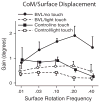Postural compensation for vestibular loss
- PMID: 19645883
- PMCID: PMC3224857
- DOI: 10.1111/j.1749-6632.2008.03708.x
Postural compensation for vestibular loss
Abstract
To what extent can remaining sensory information and/or sensory biofeedback (BF) compensate for loss of vestibular information in controlling postural equilibrium? The primary role of the vestibulospinal system is as a vertical reference for control of the trunk in space, with increasing importance as the surface becomes increasingly unstable. Our studies with patients with bilateral loss of vestibular function show that vision or light touch from a fingertip can substitute as a reference for earth vertical to decrease variability of trunk sway when standing on an unstable surface. However, some patients with bilateral loss compensate better than others, and found that those with more complete loss of bilateral vestibular function compensate better than those with measurable vestibulo-ocular reflexes. In contrast, patients with unilateral vestibular loss (UVL) who reweight sensory dependence to rely on their remaining unilateral vestibular function show better functional performance than those who do not increase vestibular weighting on an unstable surface. Light touch of <100 grams or auditory biofeedback can be added as a vestibular vertical reference to stabilize trunk sway during stance. Postural ataxia during tandem gait in patients with UVL is also significantly improved with vibrotactile BF to the trunk, beyond improvements due to practice. Vestibular rehabilitation should focus on decreasing hypermetria, decreasing an overdependence on surface somatosensory inputs, increasing use of any remaining vestibular function, substituting or adding alternative sensory feedback related to trunk sway, and practicing challenging balance tasks on unstable surfaces.
Figures



Similar articles
-
Improvements in trunk sway observed for stance and gait tasks during recovery from an acute unilateral peripheral vestibular deficit.Audiol Neurootol. 2003 Sep-Oct;8(5):286-302. doi: 10.1159/000071999. Audiol Neurootol. 2003. PMID: 12904683
-
Postural compensation for vestibular loss and implications for rehabilitation.Restor Neurol Neurosci. 2010;28(1):57-68. doi: 10.3233/RNN-2010-0515. Restor Neurol Neurosci. 2010. PMID: 20086283 Free PMC article. Review.
-
Vestibulospinal control of posture.Adv Exp Med Biol. 2002;508:139-45. doi: 10.1007/978-1-4615-0713-0_17. Adv Exp Med Biol. 2002. PMID: 12171104
-
Trunk sway measures of postural stability during clinical balance tests: effects of a unilateral vestibular deficit.Gait Posture. 2001 Dec;14(3):227-37. doi: 10.1016/s0966-6362(01)00132-1. Gait Posture. 2001. PMID: 11600326
-
Posture in otoneurology. Volume I.Acta Otorhinolaryngol Belg. 1990;44(2):55-181. Acta Otorhinolaryngol Belg. 1990. PMID: 2251926 Review.
Cited by
-
Loss of Projections, Functional Compensation, and Residual Deficits in the Mammalian Vestibulospinal System of Hoxb1-Deficient Mice.eNeuro. 2015 Dec 26;2(6):ENEURO.0096-15.2015. doi: 10.1523/ENEURO.0096-15.2015. eCollection 2015 Nov-Dec. eNeuro. 2015. PMID: 26730404 Free PMC article.
-
Postural stability in cigarette smokers and during abstinence from alcohol.Alcohol Clin Exp Res. 2014 Jun;38(6):1753-60. doi: 10.1111/acer.12409. Epub 2014 Apr 9. Alcohol Clin Exp Res. 2014. PMID: 24721012 Free PMC article.
-
Postural control in paw distance after labyrinthectomy-induced vestibular imbalance.Med Biol Eng Comput. 2020 Dec;58(12):3039-3047. doi: 10.1007/s11517-020-02276-9. Epub 2020 Oct 20. Med Biol Eng Comput. 2020. PMID: 33079344
-
Electrical tongue stimulation normalizes activity within the motion-sensitive brain network in balance-impaired subjects as revealed by group independent component analysis.Brain Connect. 2011;1(3):255-65. doi: 10.1089/brain.2011.0029. Epub 2011 Sep 12. Brain Connect. 2011. PMID: 22433053 Free PMC article.
-
Nonlinear analysis of sensory organization test for subjects with unilateral vestibular dysfunction.PLoS One. 2014 Mar 14;9(3):e91230. doi: 10.1371/journal.pone.0091230. eCollection 2014. PLoS One. 2014. PMID: 24632582 Free PMC article.
References
-
- Inglis JT, Macpherson JM. Bilateral labyrinthectomy in the cat: effects on the postural response to translation. Journal of Neurophysiology Mar. 1995;73(3):1181–91. - PubMed
-
- Horak FB. Adaptation of automatic postural responses. In: Bloedel J, Ebner TJ, Wise SP, editors. Acquisition of Motor Behavior in Vertebrates. Cambridge: MIT Press; 1996. pp. 57–85.
-
- Horak FB, Nashner LM, Diener HC. Postural strategies associated with somatosensory and vestibular loss. Exp Brain Res. 1990;82:167–177. - PubMed
-
- Buchanan JJ, Horak FB. Vestibular loss disrupts control of head and trunk on a sinusoidally moving platform. J Vestibular Res. 2001–2002;11(6):371–89. - PubMed
-
- Creath R, Kiemel T, Horak F, Jeka JJ. Limited control strategies with the loss of vestibular function. Exp Brain Res. 2002;145(3):323–33. - PubMed
Publication types
MeSH terms
Grants and funding
LinkOut - more resources
Full Text Sources
Medical
Miscellaneous

